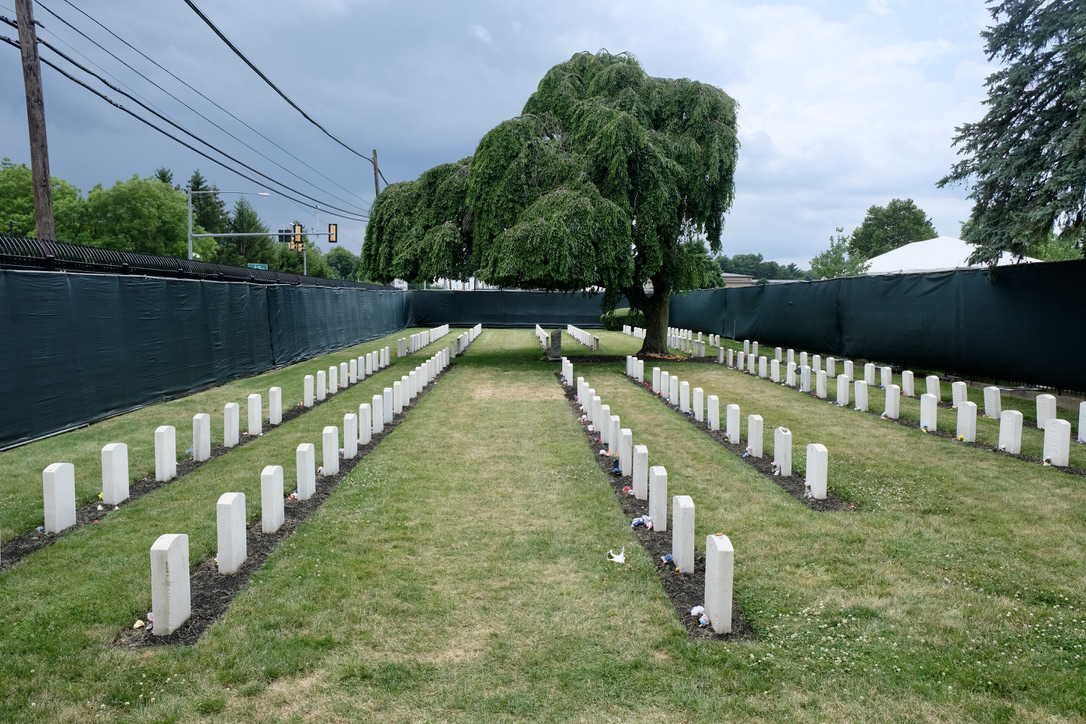
- Details
- By Jenna Kunze
After 145 years, the Sisseton Wahpeton Oyate are done waiting.
This week, the tribe’s attorney and two other attorneys for the Native American Rights Fund (NARF) sent a letter to the U.S. Army’s Department of Army Cemeteries asking for the “expeditious repatriation” of their ancestor, Amos LaFromboise, backed by the letter of federal law.
In 1879, thirteen-year-old Amos was among the initial group of Native children sent to the country’s first off-reservation federal Indian boarding school, Carlisle Indian Industrial School, in Carlisle, Pennsylvania. The son of a prominent chief, Chief Joseph LaFromboise, Amos was in line to return from Carlisle to become the next hereditary chief of his tribe. Instead, records show that the boy was the first of hundreds of children to die at Carlisle due to sickness, neglect, and abuse.
Today, the United States Army War College has taken over the grounds of the former Indian Boarding School, including its cemetery that holds the remains of more than 180 Native children.
Since 2016, the Army has used its own process to return Indigenous children that experts across Indian Country say is more stringent, restrictive, and burdensome than the federal law they believe applies, the Native American Graves Protection and Repatriation Act.
Despite the Sisseton Wahpeton Oyate following protocol and submitting paperwork — that was approved — for Amos' return in summer 2022, the Army later cited limited funding and a full roster of exhumations as reasons to delay the boy’s return home by at least another year.
“Since 2016, tribal historians, tribal archivists, tribal elders, and tribal leadership have worked to repatriate Amos from Carlisle Cemetery,” NARF attorneys and Sisseton Wahpeton Oyate’s legal counsel Megan LaFromboise, a relative of Amos’ family, wrote in the letter to the Army dated March 20. “Sisseton Wahpeton Oyate has expended significant time and resources in attempts to meet (the Department of the Army’s) elusive repatriation requirements and deadlines. Despite these efforts, DOA has still not returned Amos, largely due to obstacles that result from DOA’s unsupported position that its internal repatriation policies apply, rather than NAGPRA repatriation framework.”
In 1990, Congress enacted NAGPRA to provide a process for federal agencies and museums that receive federal funds to repatriate or transfer certain Native American cultural items —including human remains, funerary objects, sacred objects and objects of cultural patrimony — back to their respective tribal nations. The law also provides a process for federal agencies to address new discoveries of Native American human remains, funerary objects, sacred objects and objects of cultural property intentionally excavated or inadvertently discovered on federal or tribal lands.
The Army has maintained that NAGPRA doesn’t apply to the Carlisle Main Post Cemetery “because the remains are not part of a collection,” they wrote in a Federal Register Notice of Intended Disinterment last year.
But Native American Rights Fund attorneys and the Sisseton Wahpeton Oyate—echoed by tribal leaders and policy experts across Indian Country—say the Army’s internal process is “inapplicable to the children buried at Carlisle Cemetery.”
“The Army’s repatriation policies are restrictive and burdensome to a degree that egregiously violates NAGPRA’s provisions and purpose,” the Native American Rights Fund wrote in a press release. “For instance, Army policies require a signed affidavit from a child’s closest living relative to initiate their repatriation. The policies provide no means of repatriation by a child’s tribe if a living relative cannot be identified.”
By contrast, attorneys note, NAGPRA allows for the tribal nation culturally affiliate with the child to request repatriation.
Additionally, Sisseton Wahpeton Oyate tribal historian Tamara St. John—who has researched her tribe’s ancestors buried at Carlisle for more than six years in preparation for bringing them home—disagreed with the Army’s insistence on communicating strictly through Amos’ closest living relative, and cutting out tribal historic preservation officers and historians like herself.
“Our elders are likely not in a position to facilitate this very complicated process of what's needed to go and retrieve this child,” St. John told Native News Online. “They are one individual for very large families. Who owns that history? We do, as a tribe.”
Since 2016, The Army has returned a total of 28 Native American and Alaska Native children home to their families in five disinterment projects. Each project was conducted for about a month during the summer.
The Army spent over $600,000 in each of the past two summers — 2021 and 2022 — to return seven to ten children, according to spokesperson John Harlow.
However, at least 171 children are still buried at the Carlisle Barracks, according to records kept by the Carlisle Indian School Digital Research Center, run by Dickinson College in Carlisle, Pennsylvania. Fourteen of those children are under headstones marked “unknown.”
Although Amos’ relative was told by Army attorney Justin Buller last year that his ancestor would be included in this summer’s disinterment project, the Army has yet to release its disinterment schedule.
On Thursday, National Cemetery spokesperson Kerry Meeker told Native News Online that disinterments would take place in the fall rather than the summer, but would not confirm whether or not Amos would be among those going home.
Earlier today, Meeker confirmed that Amos would indeed be coming home this year. “The Army currently plans to conduct the disinterment of Amos this September and the required Federal Register Notice will be published in the next 60 days,” Meeker wrote in an email to Native News Online, noting that the disinterment of Amos Laframboise will be entirely at the Army’s expense.
In that same emailed response, Meeker said the Army informed Amos’ family and the Sisseton Wahpeton Oyate Tribal Chairman last summer that the disinterment would occur during the 2023 program year. But St. John, who has been the Army’s main point of contact for the Tribe for the last six years, said neither she, nor the tribal chairman received any news from the Army about the request.
It appears that the Army did send a letter last year confirming the disinterment approval to Amos’ closest living relative, Robert Lafromboise. That letter, dated and signed March 16, 2022, was not postmarked until Dec. 21, 2022—more than nine months later and after the Army’s completion of its summer disinterments.
In that letter, attorney Buller wrote that the Army "will attempt to schedule your ancestor’s disinterment for as soon as possible, but based upon previously approved requests, we fully cannot guarantee Amos’ disinterment this summer’s cycle." He also said that a project manager would follow up to plan logistics for the disinterment.
On Friday, the tribe said it was contacted by phone and by email by Christopher Koening, an archaeologist and the Senior Tribal Liaison and Project Site Manager for the Army Corps of Engineers.
Koening sent an email to Sisseton Wahpeton Oyate Tribal Historic Preservation Officer Dianne Desrosiers, and left a voicemail for St. John “regarding the return of Amos Lafromboise for this year's effort,” St. John and Desrosiers told Native News Online.
The Tribe is referring all of its communications with the Army to its attorneys, St. John said.
“They are supposed to be talking to our attorneys,” St. John said. “I’m shocked that they’re communicating through email and phone now when we haven’t heard from them in a year.”
In the letter sent earlier this week, NARF attorneys gave the Army 90 days to respond to their letter, in accordance with NAGPRA regulations.
“While Sisseton Wahpeton Oyate maintains that repatriation is long-past-due and wish to see the return of Amos as expeditiously as possible, Sisseton Wahpeton Oyate will make reasonable efforts to DOD, DOA and OAC to complete the repatriation process in accordance with NAGPRA and its regulations,” the letter concludes.
EDITOR'S NOTE: This story has been updated to add a statement from an Army spokesperson and additional information about the Army's outreach to the Tribe about the repatriation of Amos LaFromboise.
More Stories Like This
50 Years of Self-Determination: How a Landmark Act Empowered Tribal Sovereignty and Transformed Federal-Tribal RelationsCherokee Nation Launches Digital Dictionary to Support Language Revitalization
Prairie Band Potawatomi Nation Chairman Addresses Homeland Security Contract
Lancaster County to Recognize Conestoga-Susquehannock Tribe on Massacre Anniversary
How the Gaming Economy Helps Tribes Navigate Shifting Policies
Help us defend tribal sovereignty.
At Native News Online, our mission is rooted in telling the stories that strengthen sovereignty and uplift Indigenous voices — not just at year’s end, but every single day.
Because of your generosity last year, we were able to keep our reporters on the ground in tribal communities, at national gatherings and in the halls of Congress — covering the issues that matter most to Indian Country: sovereignty, culture, education, health and economic opportunity.
That support sustained us through a tough year in 2025. Now, as we look to the year ahead, we need your help right now to ensure warrior journalism remains strong — reporting that defends tribal sovereignty, amplifies Native truth, and holds power accountable.
 The stakes couldn't be higher. Your support keeps Native voices heard, Native stories told and Native sovereignty defended.
The stakes couldn't be higher. Your support keeps Native voices heard, Native stories told and Native sovereignty defended.
Stand with Warrior Journalism today.
Levi Rickert (Potawatomi), Editor & Publisher


